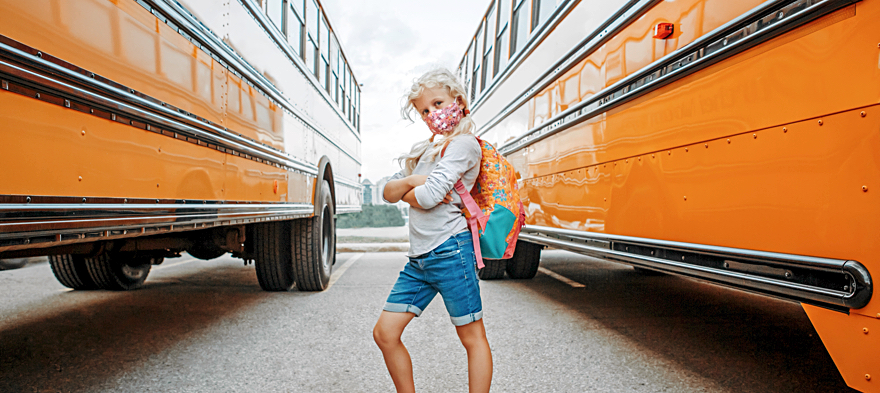
Upset parents are demanding answers about reopening schools as they watch COVID-19 case counts ramp back up while unmasked groups convene for sport and fun. Bars, gyms and restaurants have increased capacity, causing some of us to wonder: Why can my husband go out for a drink or head to the gym, but my little one can’t go to in-person school? Why can we have Halloween but not homeroom?
The coronavirus pandemic has led to a very concerning drop in public school enrollment across the country, and in Chicago, we are seeing record low enrollment for Chicago Public Schools for the first time in two decades. This could lead to irreparable downstream effects on school spending in the long term and threaten the stability of the school system. Yet, when school officials announced potentially reopening, they were met with resistance and concern..
So, [pullquote]what would it take for a city like Chicago to safely open public schools, even as COVID-19 cases may be resurging? How can we make teachers feel safe?[/pullquote]
Healthcare workers have been working together using a range of strategies to decrease risk: telemedicine for low-level care visits, staggered schedules, ventilation, physical barriers, and, of course, personal protective equipment (PPE). Hospitals and clinics have been running safely for the most part. In general, in any setting, outbreaks have been tied to eating and socializing. While it is true that doctors and nurses are trained on PPE and infection control, those approaches represent only the first line of defense.
Occupational risk strategy tells us that while PPE works, to truly mitigate risk, we must go upstream. We can start with symptom/temperature screening, HEPA filters, cohorting, and small class sizes. Systematic changes and restructuring the environment may also be needed and require planning.
Just head back to the 1918 flu pandemic for the best example. Chicago was one of three cities that included New York City and New Haven, Connecticut, to stay open. Then-Chicago Health Commissioner John Dill Robertson said of schools,
The sanitation is quite uniformly good and the hygienic conditions of environment were better than those which would have been obtained among the children if classes were discontinued.
[pullquote]City officials completely restructured the way schools looked, offering largely open-air classrooms and increased sanitation, screeners to send sick children home, and limited congregation outside of school.[/pullquote] In other words, Chicago in 1918 figured out a way to get it done.
Flash forward to 2020 where officials here and elsewhere are wrestling with how to safely open schools. They have made the right choice to prioritize re-opening for our youngest and most vulnerable students by deciding to offer in-person learning for pre-Kindergarten and special education students. This decision is strongly aligned with what is best for young children’s development. They learn through active play with peers, teachers, and materials and need social connections at this stage of their lives. This type of social interaction is virtually impossible to do over Zoom.
In addition, young children’s skill development in early childhood plays a powerful role in their later life success. If we don’t prepare young children now, it’s going to be a lot harder to play catch up later, leading to a tremendous loss in human potential and widening social inequalities. It is also reassuring that child-care programs appear not to be cluster sites for infections when facilities take appropriate precautions.
But we can’t protect our youngest students without protecting our most vulnerable teachers. We must adapt teaching modalities and physical spaces to protect those who are older and managing at-risk conditions. We must also try to keep our teachers safe, like we have tried for our healthcare workers.
[pullquote]The most important factor for safe school opening is decreasing or stabilizing COVID-19 case counts in a community.[/pullquote] Testing. Contact Tracing. Isolation. Universal masking. Social distancing. Science.
While opening schools according to these guidelines may seem costly and complicated, it can be done. Hospitals and medical centers have proven this. There is no group to “lobby” for safe school openings for the youngest except to beseech everyone’s attention: Our children need us to prioritize them now more than ever.
Laura Zimmermann MD, MS is an assistant professor at Rush University Medical Center.
If you have a child with disabilities, you’re not alone: According to the latest data, over 7 million American schoolchildren — 14% of all students ages 3-21 — are classified as eligible for special...
The fight for educational equity has never been just about schools. The real North Star for this work is providing opportunities for each child to thrive into adulthood. This means that our advocacy...
The story you tell yourself about your own math ability tends to become true. This isn’t some Oprah aphorism about attracting what you want from the universe. Well, I guess it kind of is, but...
Your donations support the voices who challenge decision makers to provide the learning opportunities all children need to thrive.
Ed Post is the flagship website platform of brightbeam, a 501(c3) network of education activists and influencers demanding a better education and a brighter future for every child.
© 2020–2024 brightbeam. All rights reserved.